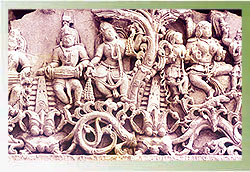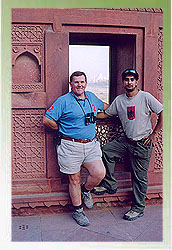|
Palaces
As
early as the fourteenth century,
stories glorifying the exotic palaces of Indian rulers
began to circulate in the West, stories which closer
acquaintance only confirmed. Even today, they are magical
places small towns rather than single buildings, in
which the Hindu and Muslim rulers of the subcontinent
dispensed their laws and enjoyed their wealth.
Palaces of
India Replicating the legendary past of the Rajas and
Maharajas, who once lived here, these palaces are the
finest example of sheer opulence and comfort. Built in
some of the most beautiful cities of the country, these
palaces are a tourists delight
These
temples of grandeur, highlight a brilliant range of
architectural style and artistry, and reflect an elegance
of style that could have only been mastered over years.
Cities, towns and villages all had their forts and
protective ramparts. It was customary to build the palace
within the fort, outside which lay the city, enclosed
within a fortified wall.
The Rajputs
were prolific builders who left behind a legacy of some of
the most imposing and magnificent forts and palaces in the
world. A bid for survival in the harsh Thar Desert and a
history replete with valor, romance and tragedy: the forts
and palaces of Rajasthan are a microcosm of the images
from the past.
Almost
every state of India have palaces built by either Muslim
or Hindu rulers but the most popular and maximum are in
Rajasthan, Andhra Pradesh, Madhya Pradesh, Gujarat and
Karnatka
Heritage
 Rich
architectural legacy of India dating to ancient past never
ceases to lure the traveler. Out of countless prestigious
heritage sites of India, sixteen cultural and five natural
have already been declared as World Heritage Sites, by the
General Conference of UNESCO. These sites are known to have an
exceptional interest and universal value, the protection of
which is the concern of all mankind. The most famous sites are Rich
architectural legacy of India dating to ancient past never
ceases to lure the traveler. Out of countless prestigious
heritage sites of India, sixteen cultural and five natural
have already been declared as World Heritage Sites, by the
General Conference of UNESCO. These sites are known to have an
exceptional interest and universal value, the protection of
which is the concern of all mankind. The most famous sites are
AJANTA
and ELLORA - Magnificent rock-cut
Buddhist cave temples. Ajanta wall paintings pulsing with
life, recount the life of the Buddha, his previous lives, as
also the court life of king and commoner, while the Ellora is
temple of three religions : Hinduism, Buddhism and Jainism.
AGRA
FORT was built by emperor
Akbar in 1565 73 AD. as his citadel. Inside are the
several palaces and the largest of pure marble mosques, the
moti masjid.
TAJ MAHAL the marble wonder
was built between 1631 and 48, by Emperor Shah Jehan for his
beloved queen Mumtaz Mahal.
 FATEHPUR SIKRI
The red stone mansions of Sikri exhibit a robust stability
combined with originality, it was built by emperor Akbar as
his capital but could rule from here for mere 12 years only. FATEHPUR SIKRI
The red stone mansions of Sikri exhibit a robust stability
combined with originality, it was built by emperor Akbar as
his capital but could rule from here for mere 12 years only.
MAMALLAPURAM
- Shore temple in south India was
founded by the Palava kings in 7th & 8th century, carved
out of rock along the coromandel coast. These monuments are
specially known for their rath mandaps and giant open-air
relief.
KONARK
Sun temple built in 1250 AD., during the reign of the
eastern Ganga king Narsima Dave I. The design is the
celestial chariot of the Sun God pulled by seven carved
ornamented horses.
KHAJURAHO
are renowned for their fine
blend of sculpture and architecture. They were built between
950 1050 A.D. under the patronage of the Chandela kings
HAMPI
The glories of medieval Hindu kingdom. Temples of this city
are noted for their large dimensions, florid ornamentation,
bold and delicate carvings and traditional depictions which
include subjects from the Ramayan and Mahabharata
PATTADAKAL-
In Karnataka, illstrates the Chalukyan art which, in the 7th
& 8th century AD, under the Chalukya dynasty, achieved a
harmonies blend of architectural forms from the north and
south of India.
ELLEPHANTA
the glorious abode of lord Shiva.
The caves were excavated in the 7th & 8th centuries. The
center piece is a massive 18 feet, three headed bust of lord
Shiva, representing his manifestations as creator, preserver
and destroyer.
SANCHI
known for its master pieces of Buddhist art Buddhist
stupas, Monasteries, Temples and Pillars dating from the 3rd
century BC. To the 12th century AD. Some other sites in line
are BRIHADISVARA temple in Tanjore, QUTAB
Complex and HUMAYUNS TOMB in
Delhi.
|



